Gord and Mary-Ann Jones assembled a Bigfoot 10-6 and Chevy Kodiak rig they named The Bee. Their quest is to stay out of their comfort zone, always move forward, and meet amazing people. Here’s how they stay alive and free in The Bee!

If there’s one thing we’ve learned from living the truck camping lifestyle for the past twenty years it’s this; there’s a direct correlation between staying still and feeling stuck, and an equally strong correlation between continuously moving and feeling free and alive.
We’ve heard this sentiment time and time again from fellow truck campers. Perhaps it’s at the core of what compels us to leave home and get back on the road. Comfort be damned. We need to break free and feel alive again—new places, new people, and new experiences. Let’s go!
Admittedly, we were drawn to Gord and Mary-Ann Jones by their bright yellow Chevy Kodiak and Bigfoot 10-6 rig. What we didn’t realize is that the size, color, and sheer audacity of the Jones’ truck and camper symbolize their determination to live their lives to the absolute fullest. It’s as if their rig says, “We’re moving forward, no matter what!” If there’s ever been a rig that so perfectly matched its owners’ positive attitudes, we don’t know it.
Taking things up a notch, Gord and Mary-Ann have significantly modified their set-up to maximize their ability to travel off-road and camp off-grid. And when that’s not enough, they tow a Jeep to take them even further. There’s no being stuck for Gord and Mary-Ann.
Ready for a heavy dose of get-out-there-and-have-some-fun truck camping inspiration? Meet Gord and Mary-Ann Jones of The Time Is Now Adventures. By the end of their interview, you may be packing your rig.
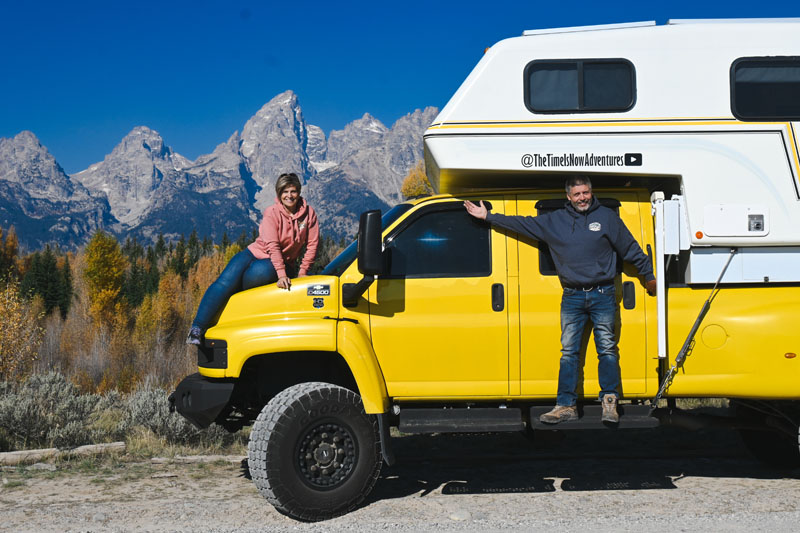
Tell us the story of how you were first introduced to camping and truck campers.
Gord: Over the years, I’ve experienced all types of camping; sleeping in my sleeping bag beside my motorbike to tent camping, camper vans, and truck campers. Growing up, my parents owned a 1970s Volkswagen camper van. We took it everywhere, traveling from Ontario to the East Coast. I grew up in Northern Ontario, where we also embarked on numerous canoe trips and remote tent camping adventures.
In the late 1990s, while living in Alberta, I bought a small truck camper. It was an affordable way for me to explore the area and the Rocky Mountains, especially since I already had a half-ton pickup. It was the perfect solution.
Mary-Ann: Camping was the only vacation I knew as a child. My dad, an avid fisherman, took our family camping and fishing at every opportunity. We started in a two-room tent and gradually upgraded to various sizes of pull-type trailers. Our adventures took us to remote areas all around British Columbia and Alberta. We would sometimes stay in these remote locations for three to four weeks at a time.
In the late 1990s, I owned a tent trailer and a small Trillium trailer, but ended up returning to tenting as it allowed for more remote camping with our truck or motorbikes. While friends and family members had truck campers over the years, this is my first experience with one.
Together we have traveled on motorbikes and tent camped, owned a camper-ized Sprinter van, and a 25 foot Class C motorhome. We renovated and traveled in the motorhome for four months over the winter of 2023/2024. Now, we have our truck and camper called “The Bee”. This setup seems to be the perfect fit for us.
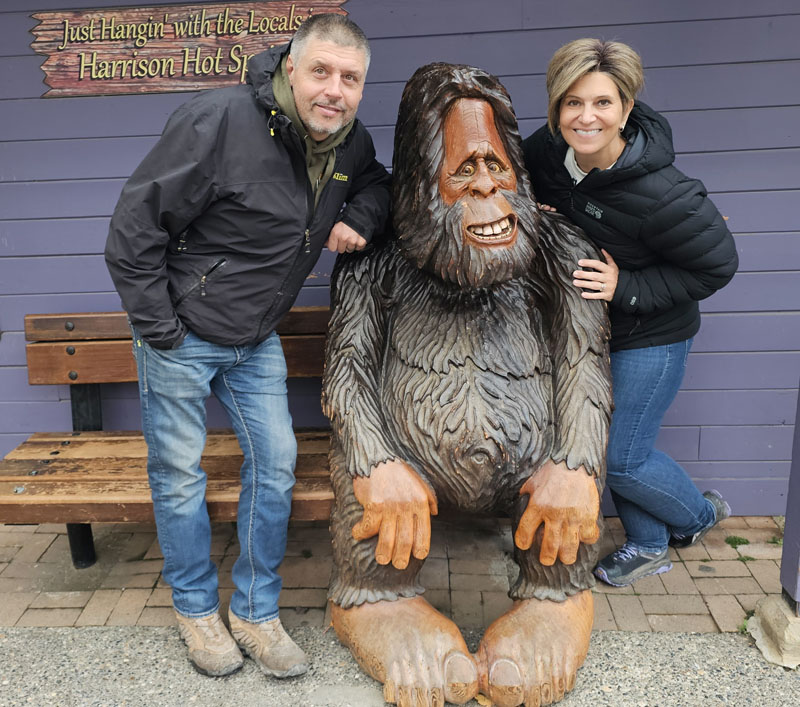
What led you to a truck camper?
Mary-Ann: While traveling in our Class C motorhome last year, we quickly realized it wasn’t a long-term solution for us. We wanted to explore more remote locations and stay away from civilization for longer periods of time. The rig needed to be relatively compact, have good towing capacity, and be off-road capable. The Class C couldn’t meet those needs. We already knew van life wasn’t for us, and a pull-type trailer didn’t check those boxes either.
After evaluating all our options, we decided a truck camper was the answer. We even had the Kodiak at home waiting for us.
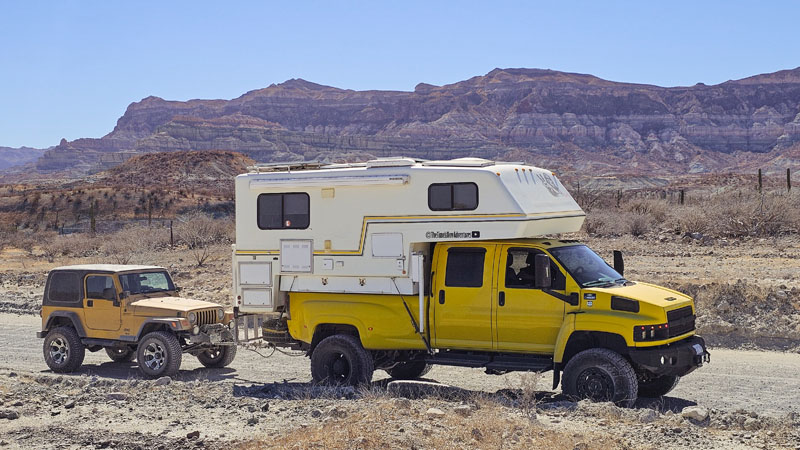
How did you go about selecting a truck camper?
Mary-Ann: We knew we wanted a truck camper designed for four seasons, with a dry bath, good water capacity, and a robust fiberglass shell. This narrowed our choices down to only a few options.
Gord: While visiting Mary-Ann’s family in Kamloops, British Columbia over Christmas, we discovered that her sister’s neighbor had a 1997 Bigfoot 25c 10.6 camper in his driveway and it was for sale. We rushed over to look at it, and it was perfect. The only problem was that we were still traveling with our Class C and had no way of getting it back to Ontario.
Once we returned to Ontario, we started the search for a used four-season truck camper. We had no luck finding what we wanted. The Bigfoot in Kamloops kept coming up in our discussions because it had everything we wanted; the perfect size, four-season capability, a heated basement with storage, 50 gallons of water storage, a dry bath, and no air conditioner so we could mount our solar panels and stay under thirteen feet.
Mary-Ann: When we saw it, it just felt right. It was in such good condition.
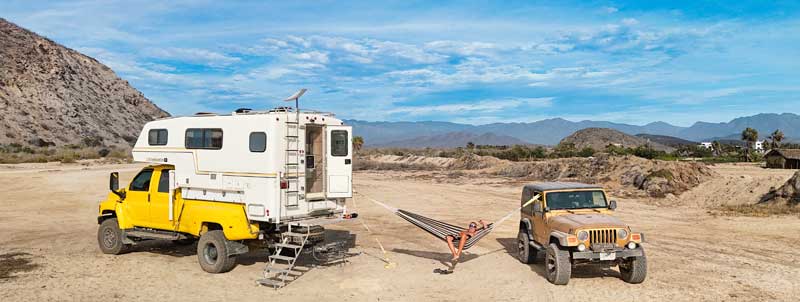
Gord: Things happen for a reason. When we called our family in Kamloops, the one across the street was still there. It was meant to be.
We still had a problem, though. How would we get it back to Ontario? Our Kodiak wasn’t set up for a camper. We called the owner of the Bigfoot, and he had just re-listed the camper for sale that day! We told him we wanted to buy it, but had to figure out a way to get it home. He then informed us that the truck it was sitting on was also for sale, so we bought the package, even though we didn’t need another truck.
We booked our flights and embarked on an 8,000-kilometer journey to get the truck and camper home. First, we flew across Canada. Then we drove the truck and camper back to Ontario.
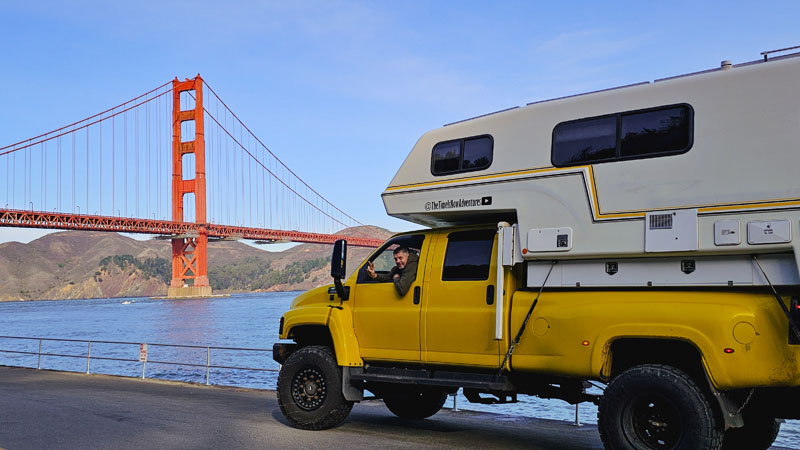
How did you know the Bigfoot and Kodiak would be a good match?
Gord: I was only concerned about the overall height. The rest we could figure out. The cab of the Kodiak is tall and we had to lift the camper ten inches to clear the cab. I was confident I could make it work.
Mary-Ann: Gord could fabricate a riser, so it wasn’t a concern. He took lots of measurements once we had the camper at home.
What did the height wind up being?
Gord: To the top of the camper, our rig is 12’8″. Looking at it, everyone thinks it’s a lot taller. When we were putting it together, being lower than 13’ was my goal. The Kodiak is so heavy and stable, so there’s no sway. I’ve had truck campers in the past, and done stuff with the suspension. In this truck, we have only added HD Shocks for a smoother ride. It’s the most stable truck camper rig I’ve ever driven.
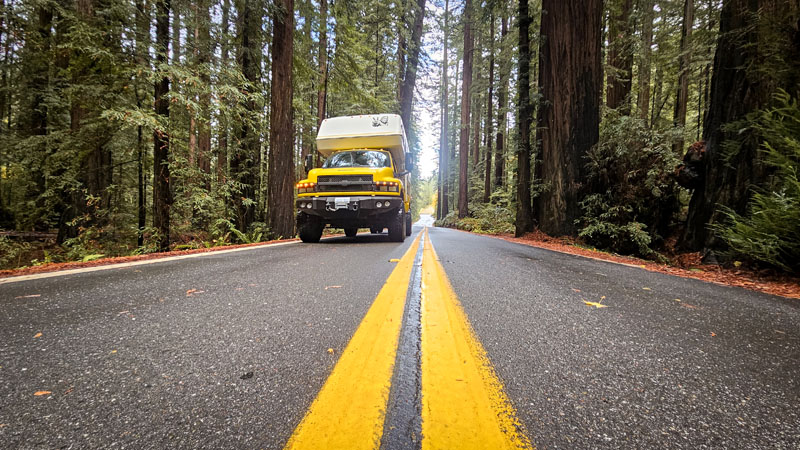
That was quite a journey to pick up your Bigfoot. Has it worked out as you hoped?
Mary-Ann: One hundred percent. We were sitting here talking about it the other night. There is not much we would change. It has checked all the boxes.
Gord: I’m an annoying shopper because I look at details so much. There’s nothing we don’t like about it. It’s exactly what we hoped it would be.
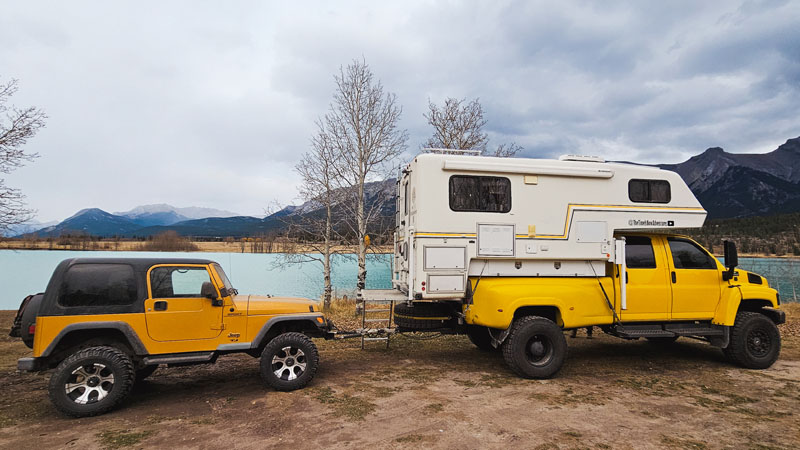
Tell us about the Jeep you have in tow.
Gord: Behind our rig, we tow a 2003 Jeep Wrangler TJ Sport. It was the best decision to bring along the Jeep. It makes it so simple to go explore even beyond what we do with the truck and camper.
The Jeep boasts a four-inch lift, 35 inch tires, and Bilstein shocks. We use a Blue Ox tow system and a Brake Buddy System for added auxiliary braking.
Mary-Ann: When we were in Baja we drove on a coastal road. There was one point where we knew we were not going to take the rig. It was narrow, with soft sand, and narrow ledge roads. We got out to a beautiful remote camp with the ocean and green hills and parked the camper there. Then, we continued with the Jeep and went to a super remote fishing village. Had we not had the Jeep, we couldn’t have gone there.
Gord: It allows us to explore remote off-road locations that our rig can’t reach. We also use it for exploring townsites and handling basic chores like laundry and grocery shopping. Having a Jeep is another thing that simplifies our life on the road. We see so much more with the Jeep.

What do you primarily use your truck camper to do?
Mary-Ann: Our rig serves as our home and office for at least half of the year, allowing us to explore a diverse range of destinations and cultures.
So far, we’ve journeyed through the western half of Canada, over twenty U.S. states, and Baja, Mexico—primarily boondocking along the way. Our rig is also used as a production studio for our YouTube channel, which documents all of our travels and adventures.
Do you work from the road?
Mary-Ann: We are semi-retired. Gord had a power sports business for twenty five years and sold it two years ago. We decided that we’re healthy and have the time, so now is the time to travel.
We have an AirBnB during the summer, which keeps us busy. Plus, we have our YouTube channel, so we are editing, have correspondence with our brand sponsorships, and maintain our website and social media accounts. All of our video editing and production is done from our dinette table.

Have you made any modifications to your truck or camper to make it fit your needs?
Gord: Yes! It’s a long list! Let’s start with the truck. We swapped out the dually wheels for 42 inch military super single wheels and tires to enhance our off-road capabilities and improve ride comfort.
We removed the back seat to create a garage and storage area. We fabricated a custom bed riser platform and side storage boxes to accommodate the camper, allowing it to clear the tall truck cab.
We crafted a custom hitch extension/spare tire mount for towing the Jeep and spare tire storage. We built a custom center console for electronic storage, including an inverter with AC power and house battery charging while driving—if needed.
In the camper, we reinforced the jack mounts and fabricated jack extensions to accommodate our tall truck. We installed 1,000 watts of solar, 400 amp hours of lithium batteries, a 2,000 watt inverter, a 40 amp lithium battery charger, a shore power auto transfer switch, and a Victron battery monitoring system.
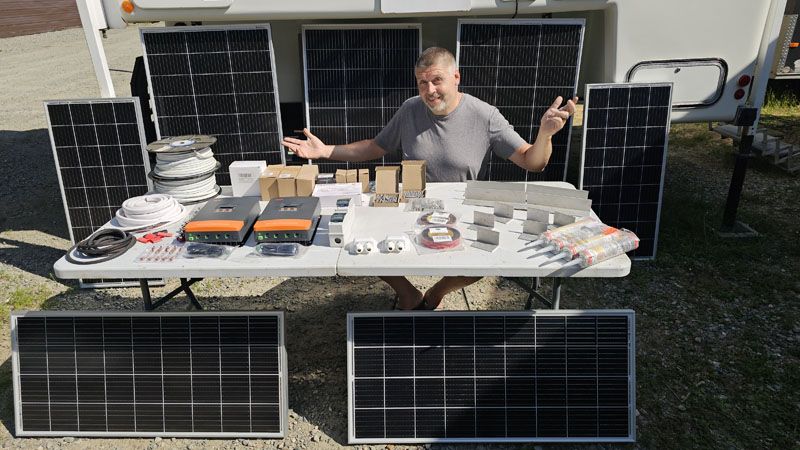
We also added an auto-switching propane valve, equipped our rig with Starlink Internet, upgraded to LED interior lighting, added USB and USB-C charging ports throughout, installed a programmable electronic thermostat, fitted in a 12-volt compressor refrigerator/freezer, installed a drinking water filtration system, built a custom composting toilet, made numerous cosmetic interior upgrades, removed the original exterior decals, added custom decals and pinstriping, and fabricated and installed a retractable rear deck and stairs.
We made all these modifications to ensure we are perfectly equipped to go remote and off-grid for weeks at a time while still enjoying all our creature comforts and having the power capabilities to run our office and produce/upload our YouTube videos without interruption.
Tell us about your water filtration system.
Gord: When we traveled last year, we had a separate five gallon water jug for drinking water. We filled up at purified drinking water fill stations because we are not fans of drinking city water anywhere. In our truck camper, we wanted a simple system since there’s no room for a five gallon jug. We wanted to drink from the camper water tanks. We have a Frizzlife GX99 water filtration system that filters our drinking water through a separate tap.
Mary-Ann: We wanted it so that we could get potable water from anywhere and filter out the chemicals and impurities. It’s really compact. It only filters drinking water, not all the water in our fresh tank. In Baja, we filled up at purificados, which are purified drinking water suppliers. They are everywhere in Baja. It’s extremely easy to find water there, sometimes easier than in Canada and the US.
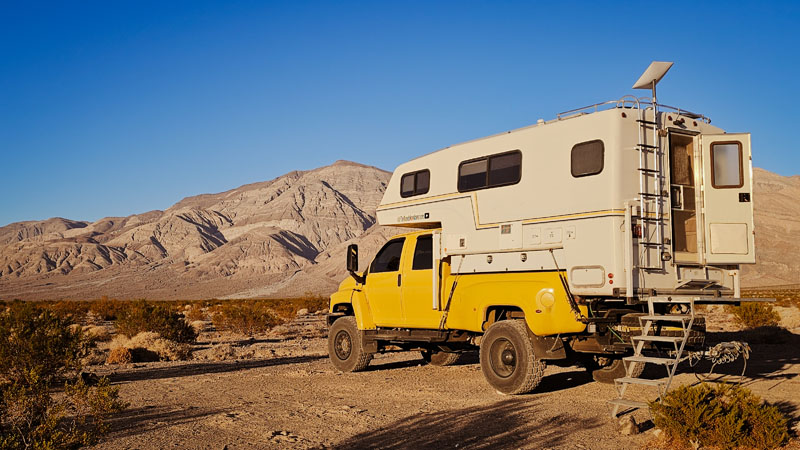
Fresh water is getting surprisingly tough to find in the US sometimes.
How has Starlink worked for you?
Gord: We need quality internet service to upload videos to YouTube. Having to upload through cell service is too slow. We would have to pick our location by cell strength and upload. It would sometimes take a day.
Mary-Ann: Now the videos are higher quality. Doing that with cellular service is not an option. We have good cell phone plans that work in Canada, the USA and Mexico, but we need a strong connection to do everything.
We’ve had no issues with Starlink. When we don’t have cell coverage, we use WIFI calling via Starlink and stay connected. There have been places where we’ve had no cell service and Starlink has worked perfectly.
Gord: I like that there are no limits to videos, calls or texts.
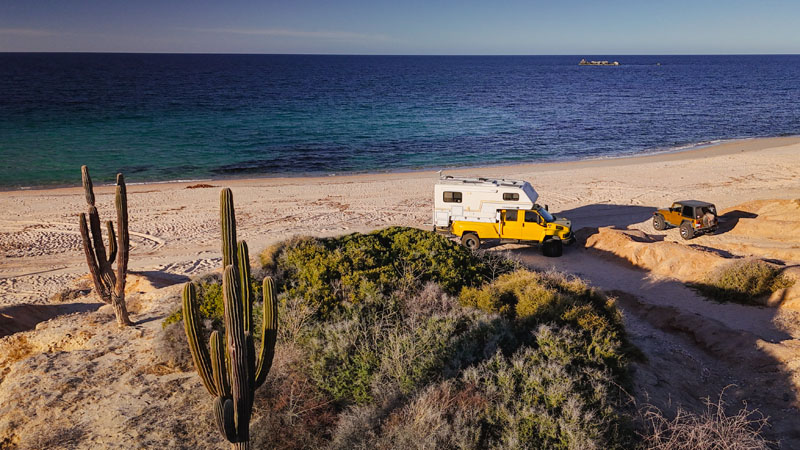
Above: Playa Punta Los Muertos, Baja camping
Mary-Ann: We also like to be remote and stay connected.
Gord: We would like to have a permanent Starlink mount as we have to put it up and down when we’re parked. It sits on a post on top of our ladder. We’d like to have a flat mount and have it on our camper 24/7.
We see people with their dish mounted on the ladder and they’re driving down the road. Our rig is already so tall that we don’t want to risk it hitting something. We’ve had Starlink at home for more than five years and it’s worked ninety-nine percent of the time. It’s rare for it to go down.
Mary-Ann: We wanted to get the Starlink Mini before we left because it’s so compact, but it wasn’t available in Canada at the time. We went with regular Starlink. We have met people with the Mini and they love it.
We have Starlink Roam, which allows us to pick it up wherever we go; Mexico, USA, and Canada. Roam for digital nomads is seamless. It always works.
Gord: You can also deactivate the service when you are not using it and not get charged.

We’ve definitely been tempted by Starlink. Tell us about your interior upgrades.
Mary-Ann: When we bought the camper, it was purple inside. You know the valances that go over the windows and over the bed? They were purple with gold. The curtains were pink and purple cotton. The dinette and kitchen windows had metal mini blinds that were awful. Our camper looked like a cotton candy nightmare.
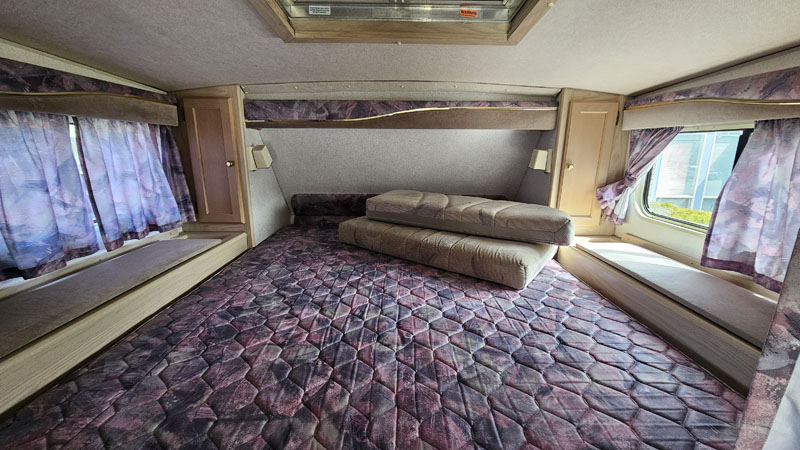
I pulled off the valances and mini blinds and re-wallpapered the whole camper. The wallpaper was white confetti looking with pink, purple, and green. It was dated.
I made new curtains and got completely rid of the blinds. Our curtains are room-darkening and thermal insulating. They’re also adjustable.
How do the curtains work?
There are multiple hooks up and down where we can roll the curtains and adjust the height. In the dinette, for example, we can have the top part covered and the bottom open. At night, we can close the bottom and open the top.
I sewed up panel curtains and installed multiple hooks and a rod on the top and bottom. The top can go to the lower hook, and the lower part can go to the top hook. It can be rolled up and out of the way. It works great if you don’t have a blind system. If the sun is beating in a window, it keeps the heat out. When it’s cold, it keeps our camper warmer. I put this on all of our windows.
I bought the biggest patio door curtains I could get instead of buying at a fabric store. That solution was cheaper, and perfect. I then cut off the ring tabs and measured them out. Next, I put a simple seam on the top and bottom. I bought curtain rods from IKEA and Gord cut them to length. It worked like a charm.
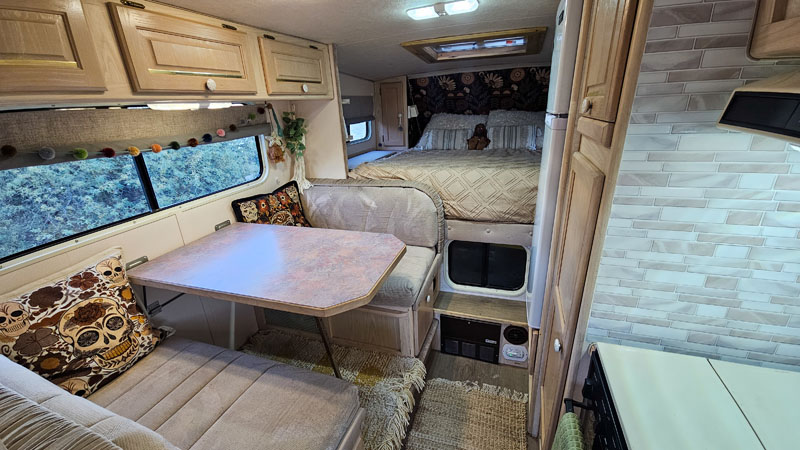
That’s a fantastic idea! We have our original Venetian blinds in our 21 year old camper. I might need to try that solution.
Did you change your cabinets?
Gord: No. The original blonde wood cabinets were in really good condition.
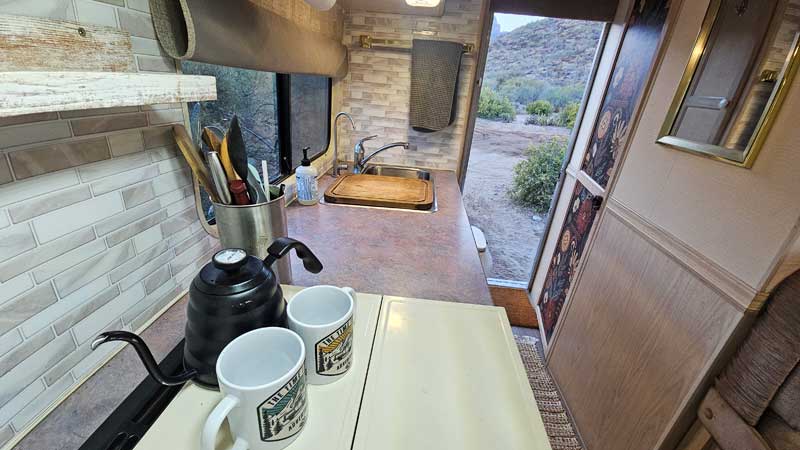
Is there anything else in the kitchen that you changed?
Mary-Ann: We added sticky tiles around the kitchen and they’ve held up well. We took the linoleum out and installed new flooring. It looks like a laminate floor.

Gord: We put in a new refrigerator. It’s a Unique 12-volt compressor design. Unique is an off-grid appliance company. Their products are not designed for a camper, but we used it in our other RV and loved it. I made custom refrigerator mounts to accommodate it in the Bigfoot.
Mary-Ann: It runs off solar and doesn’t use much power. There’s hardly any ice build up.
Gord: We wanted to simplify our power and use less propane. The 12-volt compressor is great and runs off our battery and solar system. I’ve never been impressed with any propane refrigerators I’ve had. Our 12-volt runs at the perfect temperature all the time.
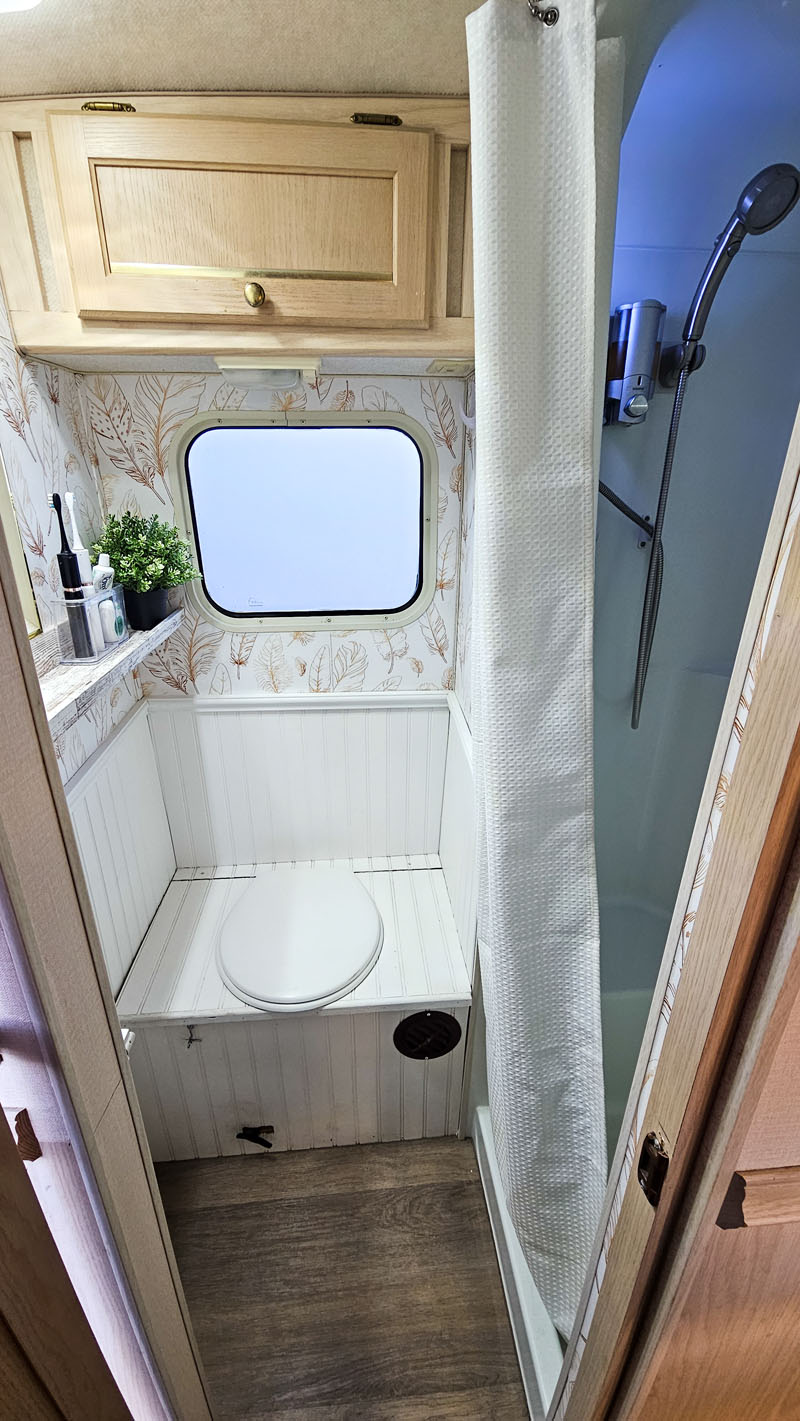
You mentioned that you made your own composting toilet. How did you do that?
Mary-Ann: The original bathroom was a dry bath. The toilet and sink sat in a corner, and the toilet lid wouldn’t easily open all the way and would jam into the corner. We wanted to simplify that. Gord pulled out the toilet and sink to gain room. He then built a box to house the toilet and installed a urine diverter, that was purchased from Amazon, that goes into the existing black tank. The solids go into a bucket lined with compost bags and coconut core.
Gord: I installed a pipe made from ABS plastic that goes to the black tank. There’s a funnel for the urine diverter and a gate valve so the sewer gasses don’t come up into the camper. In the pictures you will see a black handle on the box of the toilet that opens and closes the gate valve. I also designed and built it so that we can combine the grey and black tanks if the grey gets full.
Mary-Ann: The solids go into the bucket so there is no smell and it’s easy to clean up. We simply tie up the bag and throw it in the garbage.
Gord: For Mary-Ann it was a hard no when we started looking at composting toilets. Now that we’ve used it, it’s one of the best mods we’ve done. We don’t have to deal with the sewage part at dump stations; only the grey and urine. And because we have more capacity, we do not have to plan a trip around dump stations.

That’s a unique approach to a composting toilet. Why did you change the exterior camper graphics?
Gord: The decals on the outside were weather-beaten. We had them professionally removed because we didn’t want to risk wrecking the gel coat. Even after removal, they are still ghosted into the gel coat.
Mary-Ann: We added yellow and black vinyl pinstriping. Where the upper and lower shell seams meet, we replaced the white rubber insert with a black one to tie in with the pinstriping. We threw up a custom Bigfoot graphic on the front nose. That’s the biggest thing people comment on and gets us lots of attention on the road.
Gord: Multiple people give us the peace sign every day, even some of the military and police while we were in Baja.
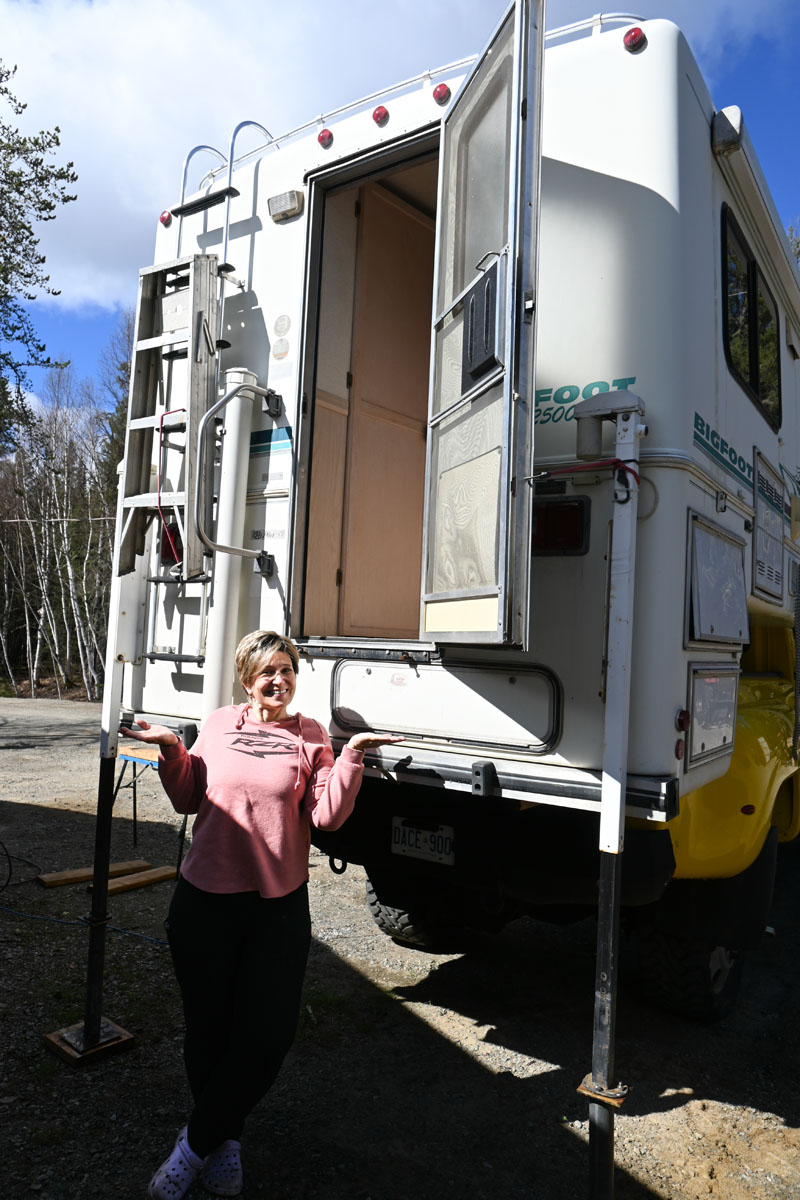
Tell me about your retractable rear deck and stairs.
Gord: That was a necessity as our camper floor is more than five feet off the ground.
Mary-Ann: I’m 5’4”. When I’m standing on the ground, the floor of our camper is even with the top of my head (photo above). A step system was definitely something we had to consider. For us, accordion-style stairs were a no.
Gord: I had to come up with a plan to make it work. The deck platform, having one step down, made it possible with a reasonable number of steps.
Mary-Ann: The steps are nice. They can be moved so that we can go up all three sides. We usually put them down on the side where our ladder is located so we have the ladder to hang on to as we go up and down. When we travel, the deck slides in and the stairs come off and hook on the back of the deck.
We have documented all our modifications on our YouTube channel, which you can check out in a dedicated playlist.
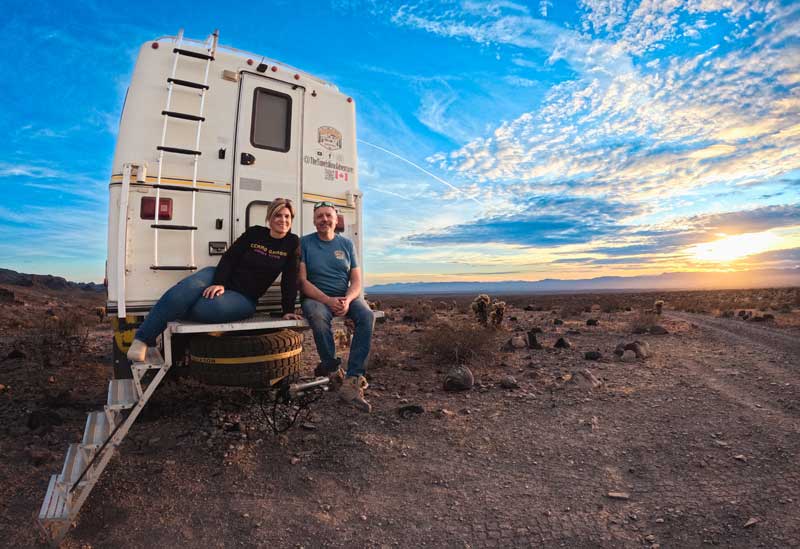
Given the height of your rig, is there anywhere you haven’t been able to go?
Gord: Not as much as you might think. There was one bridge we couldn’t go under on a back road. Nothing on the main routes. We have to watch trees that hang over the road. We’re 12’8”, so if a delivery truck can make it through, so can we.
Mary-Ann: In San Jose del Cabo, in Baja, we camped in a wash. There were one-way roads coming down on each side of a divided highway with a bridge. There were four or five openings under the bridge. We got out our measuring tape and managed to get through one of the openings so we could access the one-way road out of the wash.
Gord: We struggle to find places to wash our rig. We haven’t been able to go in some wash bays, but we’re no taller than a lot of truck camper rigs because we do not have an air conditioner and our solar is not on a rack.
From your photos, it looks like you’ve been to many places and are having a lot of fun. What does it feel like to be out on the road exploring?
Gord: Being on the road feels like we’re alive. We want to do things every day.
Mary-Ann: We are excited to get up every day. We might settle at places where we get a good vibe and stay a few days. After three or four days, we’re anxious to go again and see something new. We feel really free and alive.
Gord: Sometimes we feel it’s time to move on and have no destination in mind. We get in the truck and feel happy. We move on and figure it out from there.
Mary-Ann: We feel light on the road. When we went home last year, we felt weighed down by our excess possessions. We were saddened and depressed, missing the road and the sunshine.
Gord: Once you spend time in your camper, it becomes your home. You feel at home and you call it home. And when you get home, you feel like you’re moving out of your home into your home. A week after we got home, our camper felt more like home than our house did. If that makes sense *laughing*.
Mary-Ann: You know the feeling of walking into your childhood home and there’s a familiar smell from when you were a kid. You instantly take a deep breath and feel nostalgic. That’s what it felt like last year after being at home and then going into the camper. It felt so good. Our sticks and bricks home felt foreign. It’s a hard feeling to describe when you’re on the road every day.
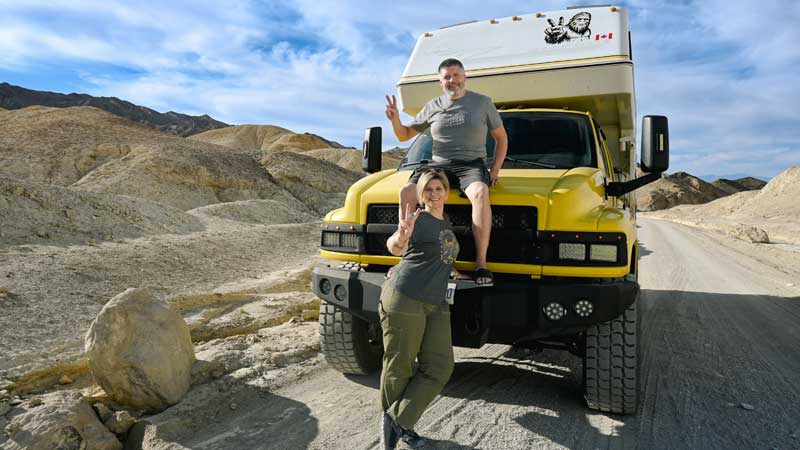
We can definitely relate to that.
Gord: We prefer unknowns. We prefer constant change. The quest for comfort is a fast track to aging. Most people have less drive. They are on the couch more. When you are out of your comfort zone, you do more.
Mary-Ann: When some people retire, they stop doing stuff every day. They just sit and seem to age instantly. We don’t want that.
Gord: Right now, a lot of people are staying home in their bubbles. They are talking to the same people and hearing the same input all the time. When you’re on the road, you see more, meet more people, and you are more open-minded. Whatever people think about things in the world, they can get along and have great conversations.
Mary-Ann: Baja is the perfect example. People said to us, “You’re going to die in Baja”. The media has made it scary. We didn’t have that experience at all. People were so friendly and kind to us. It was the complete opposite. P
A lot of people won’t go because they’ve heard it’s bad. When you are on the road and experience things, you’ll find out that a lot of times, what you hear on the news are opinions or preconceived notions, and not true at all.
Gord and Mary-Ann’s Rig
Truck: 2007 Chevy Kodiak 4500 4×4 crew cab, 42″ military super single wheel and tires, diesel, long bed
Camper: 1997 Bigfoot 25c 10.6 B
Tie-Downs and Turnbuckles: Torklift Fastguns
Suspension: HD King Shocks
